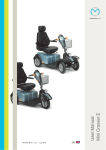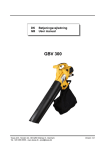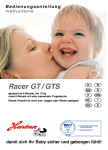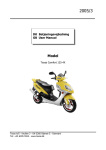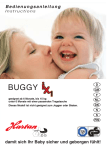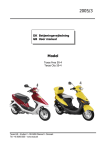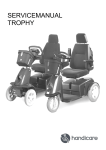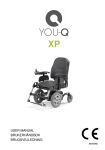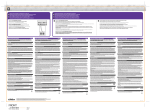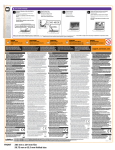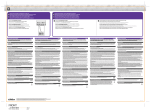Download TROPHY - Indy Mobility
Transcript
USER MANUAL BRUGERMANUAL TROPHY 9002432B 2 English ........................................................................................ 4 Dansk ........................................................................................ 26 3 English © 2008 Handicare All rights reserved. The information provided herein may not be reproduced and/or published in any form, by print, photoprint, microfilm or any other means whatsoever (electronically or mechanically) without the prior written authorization of Handicare. The information provided is based on general data concerning the constructions known at the time of the publication of this manual. Handicare executes a policy of continuous improvement and reserves the right to changes and modifications. The information provided is valid for the product in its standard version. Handicare cannot be held liable for possible damage resulting from specifications of the product deviating from the standard configuration. The available information has been prepared with all possible diligence, but Handicare cannot be held liable for possible errors in the information or the consequences thereof. Handicare accepts no liability for loss resulting from work executed by third parties. Names, trade names, etc. used by Handicare may not, as per the legislation concerning the protection of trade names, be considered as being available. 2008-01 4 Table of contents Introduction...................................................................................................................6 This manual ............................................................................................................6 Product reference ...................................................................................................6 Service and technical support .................................................................................6 Identification plate ...................................................................................................6 Approval ................................................................................................................7 CE declaration ........................................................................................................7 Warranty ................................................................................................................7 Liability ................................................................................................................9 Used scooters and the environment .......................................................................9 1 Safety ...................................................................................................................10 1.1 General safety instructions............................................................................10 1.2 Decals and instructions on the scooter .........................................................10 1.3 Electronic safety............................................................................................10 2 General description ............................................................................................11 2.1 Product description .......................................................................................11 2.2 Main components..........................................................................................12 2.3 Tiller console and operating panel ................................................................13 2.4 Battery indicator ............................................................................................14 2.5 Speed............................................................................................................14 2.6 Indicators ......................................................................................................14 2.7 Warning lights ...............................................................................................14 2.8 Speed, daily distance and total distance .......................................................14 2.9 Brake button (option).....................................................................................14 3 Operating instructions .......................................................................................15 3.1 Inspection before use....................................................................................15 3.2 Getting in and out..........................................................................................15 3.3 Free wheel lever ...........................................................................................16 3.4 Switching on the scooter ...............................................................................16 3.5 Driving...........................................................................................................17 3.6 Obstacles ......................................................................................................17 3.7 Operation ......................................................................................................18 3.8 Reducing the scooter ....................................................................................19 3.9 Transport.......................................................................................................20 3.10 Seat adjustments ..........................................................................................20 3.11 Adjustment options .......................................................................................21 3.12 Coding the combination lock .........................................................................21 4 Maintenance ........................................................................................................22 4.1 Maintenance table.........................................................................................22 4.2 Batteries........................................................................................................22 4.3 Checking and inflating the tyres ....................................................................23 4.4 Cleaning the scooter .....................................................................................23 5 Troubleshooting..................................................................................................24 5.1 Troubleshooting table....................................................................................24 6 Technical specification ......................................................................................25 5 Introduction Service and technical support Introduction For information concerning specific settings, maintenance or repair work, please contact your dealer. Make sure you always mention the model, year of manufacture and identification number. This information is provided on the identification plate of the product. A service manual is available for the dealer. This manual With this manual you can safely use and maintain (clean) the product. In case of doubt always contact your dealer. Strictly follow the procedures with a caution symbol! These procedures can - if they are not executed properly - result in human injury or damage to the product or the environment. Identification plate C B MAX. 2,4 BAR D A MAX. 2,2 BAR Product reference A B C D 6 Free wheel Identification plate Tyre pressure front wheel(s) Tyre pressure rear wheels A B C D E Model Year of manufacture Identification number User area indoors or outdoors Maximum load in kg Introduction Approval The product meets the following standards: 1. EN12184 (1999) Electrically driven wheelchairs and scooters, class C. 2. ISO7176-8 Requirements for impact, static and fatigue strength. 3. ISO7176-9 Climate tests for electric wheelchairs and scooters. 4. ISO7176-14 Standards and test methods for controller systems of electrically driven wheelchairs. 5. ISO7176-16 Requirements of resistance to fire. The product is EMC (Electro Magnetic Compatibility) approved in accordance with EN12184 (1999). CE declaration The product is in conformity with the provisions of the Medical Devices Directive and thus has CE marking. Warranty In the following warranty and liability stipulations the terms and definitions as summed up hereafter must be explained as follows: Product: The hand-operated or electric wheelchair or scooter manufactured and delivered by Handicare. Customer: The person who directly obtains a Product from Handicare. Dealer: The person who delivers a Product obtained from Handicare to customers or third parties. User: The person who uses a Product manufactured by Handicare. Irrespective of what is determined concerning warranty conditions applicable to the Product, in any case the following applies with regard to the warranty: 1. Except insofar as described otherwise Handicare guarantees the Product for its suitability for the purpose for which the Product is intended - all of these points as described in this manual - and for the quality of the material of which the Product is made and the manner in which the Product is manufactured. 2. Repairs or replacement of parts of the Product that may be necessary as a result of faults that are based on qualitatively faulty material or manufacturing errors will be executed free of charge, as long as such faults occurred within one (1) year after the date of delivery of the Product to the Customer. The parts to be replaced must be shipped post-paid to Handicare. Disassembly or assembly of these parts is for the expense of the Customer. Therefore the following cases are not eligible for free repair or replacement as meant above: • The repair or replacement that is necessary in connection with faults that arise after one (1) year after the date of delivery of the Product to the Customer; • The repair or replacement that is required in connection with faults due to improper or careless use of the Product or that are based on the Product being used for another purpose than the one for which it is intended, in which regard it applies that if the Customer is a Dealer, this Dealer will indemnify Handicare against possible claims from Users or other third parties for faults based on an incorrect or careless use of the Product; 7 Introduction • Parts that are subject to wear, and the need for repair or replacement of the parts are the actual consequence of normal wear. 3. Irrespective of that stipulated under 2, it applies as far as an electric Product is concerned that with regard to the battery that forms part of the Product warranty is only given in case of faults or nonfunctioning of the battery that are demonstrably the direct consequence of material or manufacturing errors. A fault or non-functioning of the battery as a result of normal wear is not covered by the warranty as meant in these warranty stipulations. Similarly not covered by the warranty are faults or nonfunctioning that are the consequence of improper or unprofessional use of the Product or the battery that is part of the Product, including the incorrect charging of the battery and the failure to carry out timely and good maintenance, in which context it also applies that if the Customer is a Dealer, this Dealer will indemnify Handicare against possible claims from Users or other third parties that are based on the above mentioned improper or unprofessional use of the Product or the battery that is part of the Product. 4. The warranty conditions as mentioned in above stipulations in any case become null and void if: • The guidelines of Handicare for the maintenance of the Product are not, or insufficiently, followed; • A necessary repair or replacement of parts is based on neglect, damage or abuse of the Product or a use of the 8 5. 6. 7. 8. Product for another purpose than the one for which it was intended; • Parts of the Product are replaced by parts of another origin than those which Handicare uses and/or parts of the Product are replaced without the permission of Handicare. The warranties as mentioned in stipulations 1 through 3 also become null and void if what is involved is re-used by a new user within the warranty period and that such re-use necessitates adaptations to the product and those adaptations are carried out without the instructions and/or at the order of Handicare. To retain rights under the above delineated warranties the Customer must, in case of damage or other calamities, as rapidly as possible contact Handicare and inform them as fully as possible. The possibility of taking recourse to the abovementioned warranty conditions becomes null and void for the Customer in any case after 20 workdays after the claim situation or the calamity arises that was the reason for the recourse to the guarantee. The replacement of a part or the repair or the reconditioning of the Product within a current warranty period does not extend the warranty period. Handicare gives no warranty on repair to or reconditioning of the Product carried out other than under order of and/or at the instructions of Handicare. If repairs and/or reconditioning are executed by or on behalf of a Customer, the Customer indemnifies Handicare with respect to the claims of third parties who result, in the broadest Introduction sense of the word, from such repairs or reconditioning. electronic waste. Used batteries belong to chemical waste. Liability Irrespective of what is determined regarding liability in the general conditions applicable to the Product, with regard to liability in any case the following applies: 1. Taking into consideration the following stipulations, Handicare only accepts liability for loss due to death or physical injury that is the result of a defect in the Product for which Handicare is responsible and for damage to another object that is the private property of the user of the Product, as long as said loss is the direct result of a fault in the Product. At all times, the liability of Handicare is limited to the amount which is being covered by the thirdparty insurer of Handicare. 2. Handicare accepts no other or further liability than delineated under 1. In particular Handicare accepts no liability for consequential damage, in any form whatsoever. Used scooters and the environment If your scooter has become superfluous or needs to be replaced, it can usually be taken back by your dealer. If this is not possible, please contact your local authorities for the possibilities of recycling or an environmentally friendly way of disposing of the used materials. For the production of the scooter several plastics and metals have been used. The scooter also contains electronic components that must go to 9 Safety 1 Safety Handicare accepts no liability whatsoever for damage or injury caused by the failure to (strictly) adhere to the safety guidelines and instructions or else due to carelessness during the use and cleaning of the scooter and possible accessories. Depending on the specific work circumstances or the accessories used, additional safety instructions may be required. Please contact your dealer immediately if you observe a potential danger during the use of the product. 1.1 General safety instructions • 1.3 • • • • • • 1.2 • 10 The user of the scooter is at all times fully responsible for the fulfilment of the locally applicable safety regulations and guidelines. The technical specifications must not be altered. Modifications to (parts of) the scooter are not permitted. Decals and instructions on the scooter Signs, symbols and instructions placed on this scooter comprise part of its safety facilities. They must never be covered or removed and must remain present and clearly legible throughout the entire lifespan of the scooter. Immediately replace or repair illegible or damaged signs, symbols and instructions. Contact your dealer with regard to this. Electronic safety The standard version of your scooter has been tested according to the strictest EMC requirements. Mobile telephones have no influence on the driving behaviour of the scooter. When using a mobile telephone in the vicinity of a scooter with special adaptations, you are advised to first switch off the scooter. Your scooter may influence electromagnetic fields such as alarm systems. If the electronics of the scooter is not properly screened off, this may affect sensitive electrical appliances, such as shop alarms and garage openers. The scooter has been tested for this. Should any problems of this nature occur, please report these to your dealer immediately. General description 2 General description 2.1 Product description The Trophy is an electrically driven scooter for longer distance outdoor use. The unique suspension system, stability and manoeuvrability offer excellent driving characteristics and maximum comfort. Fully adjustable, the Trophy scooter can be tailored to optimally meet your specific requirements, ensuring a relaxing position of the hands and shoulders. With controls on the right- or left-hand side the clear control panel can be easily operated with very little operating force. The Trophy scooter provides maximum independence! If you use the scooter for other purposes than those for which it is intended, Handicare accepts no liability whatsoever for damage or injury resulting from such use other than for which the scooter was developed and designed. Please study this manual carefully before you use the scooter. The Trophy has been designed for: • Transport of persons to a maximum weight of 160 kg. • Use on paved roads, sidewalks, foot- and bicycle paths. • Use in and around the house. Your dealer must give you good driver’s instructions before you can independently operate the product and participate in traffic. You must be able to correct the consequences of actions while driving the scooter. Consider operating the scooter under the supervion of an experienced dealer during first operations. The scooter is not a motorised vehicle in the sense of traffic regulations. The Trophy has a maximum speed of 15 kph. 11 General description E D C F K G L B H I A B J M 2.2 A B C D E F G H 12 Main components Rear wheels Lighting Seat Backrest Armrest Tiller console Ignition lock Mirror I J K L M Basket Front wheel(s) Tiller angle adjustment Charge connection for the batteries Lap belt, to be provided by the dealer (option) General description 2.3 A B C D E F G H I J K L M N O P Q R S Tiller console and operating panel Speed control Throttle: drive forward Throttle: reverse Indicators left/right Horn Lighting Option: forward (when using foot throttle) Option: reverse (when using foot throttle) Selector switch for speed, daily distance or total distance Option: ‘down’ (e.g. for seat with electrical high/low) Option: ‘up’ Warning lights Indicator ‘indictors switched on’ Warning lights on Speed, daily distance and total distance indicator Indicator light ‘charge battery’ Battery indicator Lights switched on Option: brake button With dual control T Right throttle U Left throttle 13 General description 2.4 Battery indicator The battery indicator shows the condition of the batteries. When all the lights are on, the batteries are fully charged. As the batteries are depleted, lights from right to left will go out. • One or more lights are on: OK. • Lights are flashing: the batteries must be charged as soon as possible. • Lights are flashing quickly: malfunction, see 5. The indicator will automatically switch off after taking a curve. The indicator can be switched off manually by pushing it once again. 2.7 Switch on the alarm lights if you fear you will not be seen by other traffic, of if you have stopped because of a malfunction. The alarm lights can also be switched on if the key is not in the ignition. 2.8 • • 2.5 If only the red lights are on, the batteries must be charged immediately. If the indicator light ‘charge battery’ is on: charge batteries. Speed The speed can be set as follows: 1. Set the desired maximum speed with the speed control (D). 2. Dose with the throttle. 2.6 Indicators The left and right turn indicator can be operated on both sides. 14 Warning lights Speed, daily distance and total distance The display shows the speed (kph), daily distance (km) or total distance (km). Press the selector switch to switch between speed, daily distance and total distance. Select daily distance and keep the key pressed in for 2 seconds to reset the daily distance. 2.9 Brake button (option) 1. Push the brake button. 2. After having used the brake button, switch off contact and reboot to drive again Operating instructions C 1 2 B A D 3 Operating instructions 3.2 3.1 1. Make sure the scooter is switched off electrically. 2. Put the free wheel handle in the DRIVE position. Inspection before use It is important to check the following points before you start driving the scooter: • If the seat is properly locked (A). • If the lights and indicators are working properly. • If the tyres are sufficiently inflated. • If the batteries are charged sufficiently. The green battery indicator lights must be on. • • In winter the batteries have a lower capacity. In case of light frost the capacity will drop to approximately 75% of the normal capacity. At a temperature of less than -5° the capacity will be approximately 50% of the normal capacity. This will affect the range. If you observe anything unusual while driving, release the throttle and take the key out of the ignition once you have stopped. Getting in and out Tiller angle adjustment Pull the handle (B) for the tiller angle adjustment (C) and push the tiller forward. Turning the seat 1. Move handle (A) forward and turn the seat 90° to the left or the right. The seat will lock automatically when turned 90°. 2. Now seat yourself on the seat. 3. Turn the seat back as described above. When the seat has been turned to its original position, it will click back into place. Folding up armrests The armrest can be folded up so that you can get in and out sideways. Sliding seat adjustment Pull up the handle (D) and move the seat forward or backward into a comfortable position. 15 Operating instructions Switch of the scooter electrically before you get in or out! This way you will avoid that the scooter starts to move when you accidentally squeeze an operating handle. B A 3.4 C 3.3 Free wheel lever Put the free wheel lever in the DRIVE position (B) to be able to drive the scooter electrically. To be able to push the scooter, put the free wheel lever in the Push (C) position. • • • 16 Never put the scooter in the Drive position when you are parked on a slope. When the scooter is parked on a slope that is too steep, it can start moving down the slope. After pushing, the free wheel lever should immediately be returned to the Drive position. The free wheel lever should only be put in the Push position if the scooter is to be pushed. In the Drive position the automatic parking brake is activated. Switching on the scooter To switch on the scooter put the key in the ignition and turn the key a quarter of a turn. When an electronics error is detected, the battery indicator will start flashing. The electronics are blocked. Make sure that the hand brake isn’t still in its parking position when you take off. Make sure no other keys / key ring are attached to the scooter’s key ring while driving. This way you will avoid that that the scooter is accidentally switched off and comes to a standstill. Operating instructions A C 3.5 • • • Select speed position 2 using the speed control (A). In the lowest speed position, the scooter will not drive. B Driving As a scooter driver you are vulnerable in traffic. Other traffic participants may not always notice you. Keep to the applicable traffic regulations. Avoid out-of-the way routes, so that help can be on its way quickly when needed. Driving forward 1. Switch on the scooter, see 3.4. 2. Use the speed control (A) to select the desired speed. 3. Squeeze the bottom part (B) of one of the operating handles. The further you squeeze the handle, the faster you will drive. Reversing 1. Release the operating handle. The scooter will come to a standstill. 2. Slowly squeeze the top part (C) of one of the operating handles. The scooter will drive in reverse. 3. When you release the operating handle, you will brake automatically. 3.6 Obstacles Driving up obstacles 1. Drive straight up to the kerb. 2. Slowly squeeze the operating handle. Drive up the sidewalk without changing direction. 3. As soon as the front wheel is on the sidewalk, you must keep your speed for the rear wheels to be able to move up the sidewalk as well. If you cannot drive up onto the sidewalk, find a lower place where you can. Driving down obstacles 1. Drive straight up to the edge of the sidewalk. 2. Slowly squeeze one of the operating handles. Drive carefully down the kerb without changing direction. • Do not drive down stairs! 17 Operating instructions • 3.7 • • In panic, release immediately the throttle. The scooter will stop automatically. Operation Switch of the scooter electrically before you get in or out! This way you will avoid that the scooter starts to move when you accidentally squeeze an operating handle. Maximum slope witch can safely be driven with maximum weight according to ISO 7176-2 is 10° at 160 kg. Driving up a slope • • • • • • Slopes with an angle of more than 10° must not be taken. Always drive slowly and with awareness on slopes. Do not drive down slopes with loose gravel or a sandy surface, as one of the rear wheels might slip. Avoid sudden and jerky movements. Avoid directional changes and turns on slopeIf you notice a strong decrease in speed when driving up a slope, take a less steep route. Driving on a slope too long can cause overheating. Driving down a slope • • • Curves • • • 18 If you need to drive down a slope, make sure the speed control is in the lowest position and drive as slowly as possible and with the utmost control. It can be very dangerous to reverse down a slope. Move the upper part of your body slightly backward and always brake slowly. If you brake fast, you may cause the scooter to tip over forward. Never take curves at full speed. Decrease speed before taking a curve. Use the indicators when changing direction. When making difficult movements, turn the speed controller in a low position. Operating instructions Miscellaneous • • • • • • • • Drive carefully on slippery roads, resulting from rain, ice or snow! Prevent the scooter from coming into contact with seawater: seawater is caustic and may damage the scooter. Prevent the scooter from coming into contact with sand: sand may can affect the moving parts of the scooter, resulting in unnecessarily rapid wear. Do not drive the scooter when you are under the influence of drugs, alcohol or medication that could affect your ability to drive. You must have sufficient eye sight to be able to safely drive the scooter. It is imperative to turn on the lights in case of reduced visibility. When driving at a high speed you must be extra careful. Select a lower maximum speed on sidewalks and in pedestrian areas. Be sure that no items of clothing hang loose. These could be caught between the wheels. A 3.8 Reducing the scooter Removing the seat 1. Move the handle (A) forward. 2. Lift the seat from the socket in which it turns. The seat can be removed more easily if you slightly turn the seat while lifting it. Folding down tiller Pull up the handle (A) and fold down the tiller (B). B 1 2 A 19 Operating instructions 3.9 3.10 Seat adjustments Transport The scooter can be placed in a car. The best way to do this is by using steel planking, across which the scooter is pushed into the car. The scooter may also be lifted; this requires at least two strong persons. B Backrest 1. Seat yourself on the seat and pull up the handle (A). The backrest will move forward. 2. Press the backrest backward by leaning back to a position that is most comfortable for you. Then push the handle down to secure the backrest in the position you have chosen. C Do not operate the handle if the seat is unoccupied, because then the backrest will come forcefully forward. A Lower-backrest Seat yourself on the seat and turn the knob (B) in such a way that the lowerbackrest reaches the most optimal position for you. • • • 20 Considering the nature of the scooter, the user is supposed to make a transfer to a regular car seat. You may not be transported in a car or taxi while sitting on the scooter, even if the vehicle concerned has been adapted for the transport of scooters. The reason for this is that a scooter cannot offer the level of safety that is offered by standard car seats, no matter how well the scooter is fixed to the vehicle concerned. After the scooter has been placed in the car, you must make sure that the free wheel lever is in the Drive position. The scooter must be secured with lashing straps at the tiedown points on the front and back of the frame. Armrest Turn the wheel (C) to adjust the height and angle of the armrest. If the position of the backrest is adjusted, this will affect the position of the armrests. 2 1 Operating instructions Headrest height Choose a comfortable height for the headrest. 3.11 Adjustment options To ensure optimal posture and positioning as well as a relaxing position of the arms and shoulders, your dealer can adjust the: • Seat height • Tiller console height • Tiller console angle • Spring tension (suspension of the scooter) 3.12 Coding the combination lock The code is set to 0-0-0 ex-works. Adjusting the code 1. Remove the button (1) using a small, sharp object. 2. Move the released button (2) in the direction of the wheels. 3. Keep the button in this position and set your personal code by turning the wheels. 4. Remember this code. 5. Release the button: your code has been set. 6. Firmly push the button (1) back in its position. 7. To unlock and release the basket, move the button to ‘open’. 21 Maintenance 4 Maintenance 4.1 Maintenance table It is recommended to have your scooter serviced by your dealer once a year or, in case of intensive use, every six months. The table below shows the maintenance activities you can perform yourself. Frequency Daily Weekly Monthly Every three months 4.2 Description Charge the batteries after each use, see 4.2. Check tyre pressure and inflate the tyres if necessary, see 4.3 Clean the scooter, see 4.4. Clean the upholstery, if necessary, see 4.4. Check the batteries (in summer: once every fortnight; in winter: once a month), see 4.2 Lubricate the turning system of the seat. 2. Put the plug of the charge cord in the charge connection, see chapter 2.2. 3. Put the plug of the battery charger in the wall outlet of the electricity mains. When the batteries have been charged: 1. Remove the plug from the charge connection. 2. Remove the plug of the battery charger from the wall outlet of the electricity mains. • • Maintenance of the batteries Refer to the battery instructions. Batteries The scooter has ‘dry’ gel batteries. These dry batteries are entirely closed and maintenance free. • • The use of ‘wet’ batteries is not permitted. Charging the batteries Consult the owner’s manual of the battery charger. In case of normal use the batteries should be charged every night. 1. Switch off the scooter. 22 As soon as the plug of the charge cord is connected to the charge connection, the operation of the scooter is switched off. Always remove the charge cord when the batteries have been charged. This way, you will prevent slow depletion of the batteries. Make sure that the batteries are always well charged. Do not use the scooter if the batteries are almost depleted and never completely deplete the batteries. This can seriously damage the batteries and you run the risk to come to an unintended standstill. Cleaning the batteries Keep the batteries clean and dry. Dirt and water can cause a leak, reducing the capacity of the batteries. After cleaning grease the poles with acidfree vaseline. Maintenance Replacing the batteries If the capacity of the batteries is reduced to the extent that the scooter can only make very short trips, the batteries are at the end of their lifespan. The batteries must be replaced as soon as possible. Contact your dealer for this. 4.3 • • Checking and inflating the tyres • • • • Never use abrasive or aggressive cleansers. They can scratch the scooter. Do not use organic solvents such a thinner, benzene or white spirit. Be careful with water in view of the electronic system. Do not dry clean, iron or spindry the upholstery. Make sure the tyres are kept at the correct pressure. The tyre pressure may never exceed the maximum value indicated on the tyre. Inflate the tyres with a foot pump or a bicycle pump, in combination with the reducing nipple included in the delivery. You can also have your tyres inflated at your local petrol station. • Tyre pressure front wheel: 2.4 bar • Tyre pressure rear wheel: 2.2 bar 4.4 Cleaning the scooter Removing dry dirt Upholstery, metal parts and frame parts can usually easily be cleaned with a dry soft cloth. Removing mud and other wet dirt The dirty parts can best be cleaned by first wiping them with a wet sponge and then wiping them dry with a dry soft cloth. Cleaning the upholstery Clean the upholstery with a damp cloth and household soap. Then wipe the upholstery dry with a soft dry cloth. 23 Troubleshooting 5 Troubleshooting 5.1 Troubleshooting table If the scooter will not function, while the batteries are fully charged, check the following points before contacting your dealer. 1. Switch off the scooter and then switch it on again. Check if the problem has been solved. 2. Check if all charge plugs are properly connected and secured. 3. Check if the scooter is in the DRIVE position (not in NEUTRAL). 4. Check if the position of the speed control has not changed. 5. In case of a malfunction the battery indicator lights will be flashing. Use the table below to find out the cause and report this information to your dealer. Number of lights 6 7 Fault description Action Scooter is connected to the battery charger. Throttle error. Disconnect the scooter from the battery charger. Make sure the throttles are not activated when the scooter is switched on. In all other cases contact your dealer. 24 Technical specifications 6 Technical specification Model Trophy 3W Max. user weight Total length Total width Total weight without batteries Transport weight of heaviest part Static stability downward Static stability upward Static stability sideways Range (ISO 7176) 85 Ah batteries Range (ISO 7176) 56 Ah batteries Dynamic stability on slopes Climbing capacity for obstacles Starting on a slope Maximum speed forward Minimum brake distance at maximum speed Idem, maximum Seat angle Effective seat depth Effective seat width Seat height front, minimum Idem, maximum Back angle, minimum Idem, maximum Back height Armrest height, minimum Idem, maximum Front armrest to backrest Minimum turning radius Capacity to drive over obstacles Ground clearance Turning space Batteries Maximum dimensions batteries Battery type Scooter weight incl batteries Maximum battery capacity Maximum battery capacity with 5 hours charging time Maximum permissible charging voltage Maximum charging current Connector type Connector type Trophy 4W Trophy Alpine kg mm mm kg kg ° ° ° km km 160 1400 660 155 90 15 15 15 60 40 166 101 - 155 90 - ° mm ° km/u 14 100 10 15 10 15 14 11 mm 2100 - - mm ° mm mm mm mm ° ° mm mm mm mm mm mm mm mm 2200 2 440 460 420 550 90 180 550 180 220 260 1250 100 70 1650 1480 1940 1250 1650 334x178x253 mm Gel/AGM 170 kg 110 Ah 27.5 Ah 13.6 V 10 A A DIN 72311 A DIN 72311 Operating force Throttle Electronic switches Parking brake Insert charge plug Wheels Diameter front wheel Diameter rear wheels Tyre pressure front wheel Tyre pressure rear wheels < 60 N < 13.5 N < 60 N < 60 N 12.5" x 2.25" 3.00x10 2.4 Bar 2.2 Bar 25 Dansk © 2008 Handicare All rights reserved. The information provided herein may not be reproduced and/or published in any form, by print, photoprint, microfilm or any other means whatsoever (electronically or mechanically) without the prior written authorization of Handicare. The information provided is based on general data concerning the constructions known at the time of the publication of this manual. Handicare executes a policy of continuous improvement and reserves the right to changes and modifications. The information provided is valid for the product in its standard version. Handicare cannot be held liable for possible damage resulting from specifications of the product deviating from the standard configuration. The available information has been prepared with all possible diligence, but Handicare cannot be held liable for possible errors in the information or the consequences thereof. Handicare accepts no liability for loss resulting from work executed by third parties. Names, trade names, etc. used by Handicare may not, as per the legislation concerning the protection of trade names, be considered as being available. 2008-01 26 Håndbogen Håndbogen ..................................................................................................................28 Brugermanual .......................................................................................................28 Produkt oversigt ....................................................................................................28 Service og teknisk service ....................................................................................28 Typeskilt ..............................................................................................................28 Godkendelser........................................................................................................29 CE overensstemmelse..........................................................................................29 Garanti ..............................................................................................................29 Ansvar ..............................................................................................................31 Udtjente scootere og miljøet .................................................................................31 1 Sikkerhed.............................................................................................................32 1.1 Generelle sikkerheds instruktioner ................................................................32 1.2 Mærkning og instruktioner på scooteren .......................................................32 1.3 Elektronisk sikkerhed ....................................................................................32 2 Generel beskrivelse ............................................................................................33 2.1 Produktbeskrivelse........................................................................................33 2.2 Bestanddele ..................................................................................................34 2.3 Styrkonsol og instrumentbord .......................................................................35 2.4 Batteri indikator .............................................................................................36 2.5 Hastighed......................................................................................................36 2.6 Blinklys..........................................................................................................36 2.7 Advarselsblink...............................................................................................36 2.8 Speedometer, dagens km og total km...........................................................36 2.9 Bremseknap (ekstra udstyr) ..........................................................................36 3 Kørsel...................................................................................................................37 3.1 Før kørsel......................................................................................................37 3.2 Ind- og udstigning .........................................................................................37 3.3 Frikoblings håndtag.......................................................................................38 3.4 Tænde scooteren ..........................................................................................38 3.5 Kørslen..........................................................................................................39 3.6 Forhindringer.................................................................................................39 3.7 Kørsel i ujævnt terræn...................................................................................40 3.8 Sammenpakke scooteren .............................................................................41 3.9 Transport.......................................................................................................42 3.10 Indstilling af sædet ........................................................................................42 3.11 Andre indstillinger .........................................................................................43 3.12 Kodning af kombinationslåsen ......................................................................43 4 Vedligeholdelse...................................................................................................44 4.1 Service plan ..................................................................................................44 4.2 Batterier ........................................................................................................44 4.3 Kontrol og pumpning af dæk .........................................................................45 4.4 Rengøring af scooteren.................................................................................45 5 Fejlfining ..............................................................................................................46 5.1 Fejlfindingsskema .........................................................................................46 6 Tekniske specifikationer ....................................................................................47 27 Håndbogen Service og teknisk service Håndbogen Brugermanual Denne håndbog forbereder dig på risikofri benyttelse og vedligeholdelse (rengøring) af køretøjet. I tvivlstilfælde henvises til at kontakte din forhandler eller relevant fagpersonale. Der henvises til forhandleren for oplysninger om den konkrete opsætning, vedligeholdelse og eventuelle reparationer. Du bedes oplyse model navn, produktions år og stelnummer. Disse oplysninger kan aflæses af køretøjets typeskilt. Servicehåndbog kan rekvireres fra forhandleren. Advarsler vises ved dette symbol. Respekter altid advarslerne nøje. Manglende overholdelse af en advarsel givet i denne håndbog kan betyde fare for mennesker eller medføre skader på køretøjet eller dets omgivelser. C B MAX. 2,4 BAR D A MAX. 2,2 BAR Produkt oversigt A B C D 28 Fri kobling Typeskilt Dæk tryk forhjul Dæk tryk baghjul Typeskilt A B C D E Model Produktionsår Stel nummer Indendørs / udendørs brug Maksimum kg. last Håndbogen Godkendelser Produktet opfylder krav og specifikationer i følgende standarder: 1. EN12184 (1999) Elektrisk drevne køre-stole, scootere og deres ladere - Klasse C. 2. ISO7176-8 Krav og prøvningsmetoder til statisk, slag- og udmattelsesstyrke. 3. ISO7176-9 Klimaprøvninger til elektriske kørestole. 4. ISO7176-14 Kraftoverførsels- og kontrolsystemer til elektriske kørestole. Krav og prøvningsmetoder. 5. ISO7176-16 Modstandsevne over for antændelse af polstrede dele Krav og prøvningsmetoder. Produktet er EMC (Electro Magnetic Compatibility) godkendt i henhold til EN12184 (1999). CE overensstemmelse Dette produkt er i overensstemmelse med bestemmelserne i EU Direktiv om Medicinsk Udstyr og er således CE mærket. Garanti I den følgende gengivelse af garantiog ansvarsbestemmelser benyttes begreberne: Produktet: Den håndstyrede elscooter produceret af Handicare. Kunden: Den person som overtager produktet direkte fra Handicare. Forhandleren: Den person som leverer produktet fra Handicare til kunden eller til 3. person. Brugeren: Den person som benyt-ter produktet fra Handicare. Nedenstående garantibestemmelser gælder i alle tilfælde uanset øvrige bestemmelser om garanti vedrørende produktet: 1. Medmindre andet er beskrevet garanterer Handicare for produktets egnethed til enhver tilsigtet anvendelse – således som det er beskrevet i denne håndbog – og for produktets med hensyn til materialer og tilvirkning. 2. Reparationer og udskiftning af komponenter som måtte nødvendiggøres af mangler ved kvalitet eller materialer eller af produktionsfejl, vil blive udført uden omkostning for kunden eller brugeren, forudsat at en sådan mangel eller fejl indtræder inden et år efter produktets levering til kunden. Den fejlbehæftede del må sendes franko til forhandleren. Afmontering og genmontering af sådanne dele skal varetages for kundens regning. Følgelig er nedenstående tilfælde ikke omfattet af Handicare garanti: • Reparationer og udskiftning af komponenter som måtte nødvendiggøres af fejl som indtræder 1 år eller senre efter at produktet er leveret til kunden. • Reparationer og udskiftning af komponenter som måtte nødvendiggøres af fejl opstået på grund af forkert eller skødesløs benyttelse af produktet, eller opstået ved brug af produktet på en måde hvortil det ikke er beregnet; i hvilke situationer en eventuel forhandler bør holde Handicare skadesløs for eventuelle krav fra brugere eller anden 3. part hidrørende fra forkert eller skødesløs brug af produktet. • Sliddele hvis reparation eller udskiftning er resultat af normal slidtage. 29 Håndbogen 3. Uanset det ovenfor under pkt. 2 bestemte, gælder det for elektriske produkter, at med hensyn til batterier som udgør en del af produktet er disse kun er omfattet af garantien i tilfælde af fejl eller funktionsmangler på batteriet, hvis sådanne mangler beviseligt er en direkte følge af materiale- eller produktionsfejl. En fejl eller funktionsmangel ved et batteri der er en følge af normalt slidtage er ikke dækket af denne garanti. Tilsvarende er fejl eller funktionsmangel der er en følge af forkert eller ukorrekt brug af produktet eller batteriet som er en del af produktet, herunder forkert opladning af batteriet eller mangel på rettidig og god vedligeholdelse, ikke dækket af denne garanti; i hvilke situationer en eventuel forhandler bør holde Handicare skadesløs for eventuelle krav fra brugere eller anden 3. part hidrørende fra forkert eller ukorrekt brug af produktet eller af batteriet som er en del af produktet. 4. Garantierstatning som fastlagt ovenfor bortfalder i alle tilfælde hvis: • Den af Handicare beskrevne vedligeholdelse af produktet udeladt eller er udført utilstrækkeligt. • En nødvendig reparation eller udskiftning forårsaget af misligholdelse, skade eller misbrug af produktet eller af brug af produktet til et andet formål end det, hvortil det er beregnet. • Dele af produktet er udskiftet med uoriginale komponenter eller dele af produktet er udskiftet uden tilladelse givet af Handicare. 5. Garantierstatning som stipuleret ovenfor pkt. 1 til 3 bortfalder, hvis 30 der som led i produktets genbrug hos en ny burger indenfor garantiperioden er foretaget tilpasninger af produktet og sådanne tilpasninger er udført uden instruktion af eller uden foranledning af Handicare. 6. For at oppebære de ovenfor beskrevne garantikrav, skal kunden i tilfælde af skader eller anden funktionssvigt, så hurtigt som muligt kontakte Handicare og informere så fyldestgørende som muligt. Adgang til at gøre regres fortabes 20 arbejdsdage efter at garantiskaden er opstået eller funktionssvigt er indtrådt som er årsag til garantikrav. 7. Erstatning af en del eller reparation eller opgradering af produktet i garantiperioden medfører ikke forlængelse af grantien. 8. Handicare yder ikke garanti på reparationer eller opgraderinger af produktet udført af andre eller uden instruktion eller ordre af Handicare. Hvis reparation eller opgradering er udført af eller på kundens ordre, skal kunden holde Handicare skadesløs for eventuelle krav fra brugere eller anden 3. part hidrørende fra reparation eller opgradering af produktet. Håndbogen Ansvar Uanset hvad der matte være bestemt af generelle betingelser omfattende dette produkt, gælder følgende: 1. I henhold til de følgende betingelser accepterer Handicare kun ansvar for tab ved dødsfald eller ved person skade som er forårsaget af en defekt ved produktet for hvilken Handicare er ansvarlig og for skader på ting som tilhører brugeren af produktet, og kun i det omfang at et sådant tab er den direkte følge af en defekt ved produktet. Handicare’s ansvar er til enhver tid begrænset til forsikringssummen dækket af Handicare’s forsikringsselskab. 2. Handicare er ikke ansvarspligtig ud over det under pkt. 1 fastlagte. Handicare fraskriver sig ethvert ansvar for følgeskader, i enhver form og udstrækning. Udtjente scootere og miljøet Når din scooter er udtjent eller står foran udskiftning, vil den ofte kunne leveres tilbage til forhandleren. Kontakt din kommunale genbrugsordning for at få vejledning til en miljørigtig bortskaffelse af køretøjet. 31 Sikkerhed 1 Sikkerhed Handicare er ikke i nogen udstrækning ansvarlig for skader eller kvæstelser forårsaget af manglende (nøje) overholdelse af sikkerheds -forskrifter og instruktioner eller forårsaget af skødesløshed under brug eller rengøring af scooteren ellers dens tilbehør. Alt efter den konkrete funktionssituation eller af det konkrete tilbehør kan yderligere sikkerhedsinstruktioner være påkrævet. Kontakt omgående forhandleren hvis du observerer en potentiel farlig situation under brug af produktet. 1.1 • • • 1.2 • 32 Generelle sikkerheds instruktioner Føreren af scooteren er til enhver tid ansvarlig for overholdelse af færdselsloven og andre gældende regler og vejledninger. Køretøjets tekniske specifikationer må ikke ændres. Det er ikke tilladt at foretage konstruktive ændringer af scooteren (og dens dele). Mærkning og instruktioner på scooteren Skilte, symboler og instruktioner placeret på denne scooter udgør en del af dens sikkerhedsudstyr. De må ikke tildækkes eller fjernes og skal forblive til stede og synlige i hele scooterens levetid. • 1.3 • • • Udskift eller reparer omgående ulæselige eller beskadigede skilte, symboler eller instruktioner. Kontakt forhandleren herom. Elektronisk sikkerhed Denne typegodkendte version af din scooter er afprøvet under de højeste EMC krav. Mobiltelefoner har ingen indvirkning på scooterens køreegenskaber. Benyttes en mobiltelefon i nærheden af en scooter med specielle tilpasninger, tilrådes det at slukke for scooteren først. Scooteren kan påvirke elektromagnetiske felter som f.eks. alarmsystemer. Såfremt scooterens elektronik ikke er korrekt skærmet, kan den påvirke visse følsomme elektriske installationer så som butiksalarmer og garageåbnere. Scooteren er testet herfor. Hvis der skulle opstå sådanne problemer bedes du kontakte din forhandler omgående Generel beskrivelse 2 Generel beskrivelse 2.1 Produktbeskrivelse Trophy er en elektrisk drevet scooter til brug over større afstande udendørs. Det unikke fjedrende ophæng, dens stabilitet og dens manøvredygtighed sikrer enestående køreegenskaber og maksimal komfort. Den er fuldt indstillelig og vil passe til præcis dine behov samtidigt med at du sidder afslappet med hænder og skuldre. Med gasknapper i både højre og venstre side af det ergonomiske styr kan den betjenes med et minimum af kræfter. Trophy’en giver frihed og uafhængighed! Hvis du benytter scooteren til andre formål end den er beregnet til, bortfalder Handicare’s ansvar for enhver skade eller ulykke som den utilsigtede benyttelse måtte medføre. Læs denne håndbog grundigt før du benytter scooteren. Trophy er designet til: • Transport af personer op til 160 kg. • Kørsel på asfalt veje, fortove, cykelstier og gangstier. • Brug inde og ude. Forhandleren eller en anden fagperson vil tilbyde dig en grundig introduktion og træning så du hurtigt føler dig tryg ved din Trophy, især i trafikken: Du skal være i stand til at kontrollere scooteren og foretage korrigerende handlinger medens du kører. Foretag de første køreture under vejledning af forhandleren eller anden fagperson. Scooteren er ikke et motorkøretøj i færdselslovens betydning. Trophy når en max. hastighed på 15 km/t. 33 Generel beskrivelse E D C F K G L B H I A B J M 2.2 A B C D E F G 34 Bestanddele Baghjul Lygter Sæde Ryglæn Armlæn Styrkonsol Tændingslås H I J K L M Spejl Kurv Forhjul Styrkonsol justering Ladebøsning til batterierne Hoftesele (ekstra udstyr) Generel beskrivelse 2.3 A B C D E F G H I J K L M N O P Q R S Styrkonsol og instrumentbord Hastighedsvælger Gasknap: Frem Gasknap: Bak Blinklys højre /venstre Horn Lygter Ekstra udstyr: Frem (hvis monteret med fod gas) Ekstra udstyr: Bak (hvis monteret med fod gas) Vælger-knap: Dagens km / Total km Ekstra udstyr: Ned (hvis monteret med sæde-lift) Ekstra udstyr: Op (hvis monteret med sæde-lift) Advarselsblink Blinklys tændt Advarselsblink tændt Display Lampe: Batterier skal oplades Batteri-indikator Lys tændt Ekstra udstyr: Bremseknap Med dual control T Gasknap: Højre U Gasknap: Venstre 35 Generel beskrivelse 2.4 Batteri indikator Batteri-indikatoren viser batteriernes ladestand. Når alle lamper lyser, er batterierne fuldt opladte. Efterhånden som batterierne aflades vil lamperne gå ud fra højre mod venstre. • En eller flere lamper lyser: OK. • Lamperne blinker: Batterierne skal oplades så snart som muligt. • Lamperne blinker hurtigt: Fejl! (se afs. 5) • • 2.5 Hvis de røde lamper lyser, skal batterierne oplades omgående. Hvis indikatorlampen P lyser, skal batterierne oplades. Hastighed Således vælges kørehastighed: 1. Vælg den ønskede max. hastighed med hastighedsvælger (D). 2. Farten doseres med Gasknappen. 2.6 Blinklys Højre og venstre blinklys kan betjenes fra begge sider. Blinklys vil automatisk slå fra efter et sving. Blinklys slås fra manuelt ved at trykke på vælgeren igen. 2.7 Advarselsblink Tænd advarselsblink hvis du frygter ikke at blive set af de øvrige trafikanter, eller i tilfælde af at du er stoppet på grund af en defekt i køretøjet. Advarselsblink fungerer også med slukket tændingsnøgle. 36 2.8 Speedometer, dagens km og total km Displayet viser hastighed (km/t,) dagens distance (km) eller total distance (km). Tryk på vælgerknappen for at skifte mellem hastighed, dagens km og total km. Vælg dagens km og hold knappen nede i 2 sekunder for at nulstille. 2.9 Bremseknap (ekstra udstyr) 1. Tryk på bremseknappen. 2. Efter at have aktiveret bremseknappen skal scooteren slukkes og genstartes for at kunne køre Kørsel C 1 2 B A D 3 Kørsel 3.2 3.1 1. Sørg for at scooteren er slukket ved tændingsnøglen. 2. Sæt Frikoblings-håndtaget i DRIVE position. Før kørsel Det er vigtigt at kontrollere de følgende punkter før du starter scooteren: • At sædet er korrekt låst (A). • At lygter og blinklys fungerer korrekt. • At dæktryk er korrekt. • At batterier er tilstrækeligt opladet. Batteriindikator lyser grønt. • • Batteriernes kapacitet er nedsat om vinteren. I let frostvejr vil deres kapacitet være reduceret til 75% af den normale. Ved temperaturer under -5° vil batteriernes kapacitet være ca. 50%. Dette vil påvirke kørestolens rækkevidde. Hvis du oplever en usædvanlig situation ved scooteren mens du kører, slip gasknappen og sluk ved tændingsnøglen straks når den holder stille. Ind- og udstigning Justering af Styr-konsol Træk i håndtag (B) for at justere styrkonsollen (C) og skub styret fremad. Dreje Sædet 1. Skub håndtag (A) fremad og drej sædet 90° mod venstre eller højre. Sædet vil låses automatisk når det står i 90°. 2. Du kan nu sætte dig i sædet. 3. Drej sædet tilbage som beskrevet ovenfor. Sædet låses automatisk, når det står i kørestilling. Opklappelige armlæn Armlæn kan klappes op så du kan komme ind og ud af sædet fra siden. Sædets frem og tilbage justering Løft i håndtag (D) og skub sædet fremad eller tilbage til den ønskede position. 37 Kørsel stillingen er den automatiske parkeringsbremse indkoblet. Sluk for scooteren ved tændingsnøglen før du stiger ind eller ud! Herved sikrer du at scooteren ikke kører hvis du ved et uheld kommer til at berøre gasknappen. B A C 3.4 Tænde scooteren Sæt nøglen i tændinglåsen og drej den en kvart omgang. 3.3 Frikoblings håndtag Frikoblings håndtag skal stå i DRIVE stillingen (B) for at scooteren kan køre. Vrid frikoblings håndtag til PUSH stilling for at kunne skubbe eller bugsere scooteren. • • • 38 Sæt aldrig scooteren i Push stilling når den er parkeret på et skrånende underlag. Hvis scooteren parkeres på en for stejl skråning, kan den rulle nedad. Efter endt bugsering skal Frikoblings håndtag straks føres tilbage til Drive stilling. Frikoblings håndtaget må kun befinde sig i Push stilling når scooteren skubbes. I Drive Hvis systemet finder en elektrisk fejl, vil batteridispalyet blinke. Scooterens elektroniske styring vil være blokeret. Undersøg om bremseknappen (ekstra udstyr) er aktiveret. Sørg for at der ikke hænger andre nøgler eller tunge genstande i nøgleringen før du kører. Derved forhindres at nøglen ved et uheld drejer sig under kørslen og dermed slukker for scooteren. Kørsel A C 3.5 • • B Kørslen På en scooter er du en af de “bløde trafikanter”. Vær altid opmærksom på, at ikke alle andre trafikanter får øje på dig. Overhold altid færdselsreglerne. Undgå færdsel på øde steder, så hjælp kan nå hurtigt frem hvis uheldet skulle være ude. Køre fremad 1. Tænd scooteren, se 3.4. 2. Vælg den ønskede max. hastighed (A). 3. Klem forsigtigt foroven på den valgte gasknap (B) – højre eller venstre. Jo længere gasknappen presses ind, desto hurtigere kører du. Køre baglæns 1. Slip gasknappen og scooteren vil standse. 2. Klem forsigtigt forneden på den valgte gasknap (C). Scooteren vil nu bakke. 3. Når gasknappen slippes, vil den automatiske holdebremse koble ind. 3.6 Forhindringer Om at køre op på niveauforskelle 1. Kør altid lige på en op- eller nedkørsel. 2. Tryk gasknappen langsomt ind. Kør nu lige op på fortovet uden at dreje før du er helt oppe. 3. Når først forhjulet er oppe på fortovet, skal du holde farten indtil også baghjulene er kommet op. Hvis det ikke lykkes at komme op på fortovet, søg da en anden, lavere opkørsel. Om at køre ned ad niveauforskelle 1. Kør lige frem mod fortorvskanten. 2. Tryk gasknappen langsomt ind. Kør nu ned fra fortovet uden at dreje før du er helt nede. • • Kør aldrig ned ad trapper! I nødsfald: Slip omgående gasknappen. Scooteren vil standse af sig selv. 39 Kørsel 3.7 • • Kørsel i ujævnt terræn • Sluk for scooteren ved tændingsnøglen før du stiger ind eller ud! Herved sikrer du at scooteren ikke kører hvis du ved et uheld kommer til at berøre gasknappen. Den stejleste skråning som kan forceres med fuld last 160 kg er 10° ISO 7176-2. Læn dig bagover mod ryglænet og brems altid forsigtigt. Hvis der bremses brat ned ad en bakke, kan det få scooteren til at tippe forover. Om at køre op ad bakke • • • • • • Prøv aldrig at køre på steder som skråner mere end 10°. Kør altid i roligt tempo og vær opmærksom på om terrænet skråner. Kør aldrig op ad en skråning med grus eller anden løs overflade, da der her vil være risiko for at et hjul mister vejgrebet, og scooteren kommer ud af kontrol. Undgå pludselige bevægelser i ryk. Undgå at svinge eller skifte retning mens du kører op ad en skråning. Hvis du oplever at køretøjet mister kraft på vej op, vælg en mere flad rute. Der er risiko for overbelastning hvis du forsøger at køre op ad en for lang bakke. Om at køre ned ad bakke • • 40 Drej altid hastighedsvælgeren til laveste fart når du skal køre ned af en bakke og kør så roligt som muligt med stor forsigtighed. Det kan være farligt at skifte kørselsretning på en bakke. Om at køre i sving • • Kør aldrig i et sving med fuld fart. Sæt farten ned inden du drejer! Benyt blinklys når du drejer. Sæt hastighedsvælger til langsom inden der foretages en vanskelig drejning. Kørsel B 1 2 A A Advarsler • • • • • • • • Kør altid forsigtigt i glat føre! Scooteren må ikke udsættes for saltvand, som kan beskadige den. Scooteren må ikke udsættes for sand. Sand kan beskadige de bevægelige dele og forårsage unødvendig slid. Kør aldrig scooteren, hvis du er påvirket af narko, alkohol eller medicin som kan påvirke din evne til at føre køretøj. Føreren skal have tilstrækkelig synsevne til sikkert at kunne føre scooteren. Tænd altid kørelys ved nedsat sigtbarhed. Kørsel i høj fart kræver ekstra forsigtighed. Vælg lavere fart ved kørsel på fortov, gågader mv. Pas på at der ikke er løst tøj eller andre løse genstande som kan komme ind i køretøjets hjul. 3.8 Sammenpakke scooteren Afmontere sædet 1. Før håndtag (A) frem. 2. Løft sædet ud af røret det sidder i. Det er lettere at løfte sædet op hvis du drejer det fra side til side mens det løftes op. Lægge styrkonsollen ned Træk i håndtag (A) og læg konsollen ned (B). 41 Kørsel 3.9 3.10 Indstilling af sædet Transport Scooteren kan tages med i en bil. Den enkleste måde er benytte et sæt køreslisker til at skubbe scooteren op i bilen. Man kan også løfte scooteren op – der skal være mindst to personer hertil. B Ryglæn 1. Sæt dig op i sædet og træk i håndtag (A). Ryglænet vil nu glide fremad. 2. Pres ryglænet bagud ved at læne dig op ad det indtil den mest komfortable stilling er nået. Skub nu håndtaget (A) nedad for at fastlåse ryglænet I den valgte position. C Udløs aldrig ryglænet uden at nogen sidder i sædet, da ryglænet ellers vil springe frem med stor kraft. A Nakkestøtten Indstil nakkestøtten til den ønskede højde. • • • 42 Det er ikke tilladt at sidde på scooteren under transport i en bil; end ikke hvis den pågældende bil er indrettet til transport af scootere og kørestole. Brugeren skal skifte til et af bilens sæder og anvende bilens monterede selesystemer. Årsagen hertil er at en scooter ikke yder den samme grad af beskyttelse som et typegodkendt autosæde, uanset hvor grundigt scooteren er fastspændt i bilen. Når scooteren er placeret i en bil, skal Frikoblingshåndtaget være placeret i Drive position. Scooteren skal fastgøres med surringsstropper i de dertil mærkede surringpunkter foran og bagpå. Lændestøtten Sæt dig i sædet og drej i håndhjulet (B) frem eller tilbage indtil du opnår den ønskede lændestøtte. Armlæn Drej rullen (C) indtil armlænet står i den ønskede vinkel / højde. Når ryglænets vinkel justeres, ændres armlænenes position. 2 1 Kørsel 3.11 Andre indstillinger For at sikre en optimal siddestilling såvel som en afslappet holdning i arme og skuldre, har forhandleren mulighed for at tilpasse: • Sædets højde • Styr-konsolets højde • Styr-konsolets vinkel • Støddæmpning (scooterens affjedring) 3.12 Kodning af kombinationslåsen Koden er fra fabrikken sat til: 0-0-0 Ændre koden 1. Fjern låget (1) ved hjælp af et lille skarpt værktøj. 2. Skub udøserknappen (2) ind mod nummerhjulene. 3. Hold udløserknappen i denne stilling medens du drejer nummerhjulene til din personlige kode. 4. Husk denne kode! 5. Slip udløserknappen og din kode er nu sat. 6. Tryk låget (1) helt fast igen. 7. Kurven åbnes og løftes op ved at skubbe knappen over mod ‘open’. 43 Vedligeholdelse 4 Vedligeholdelse 3. Sæt laderens netstik i vægkontakten og tænd. 4.1 Når batterierne er opladede: 1. Sluk for strømmen og træk stikket ud af vægkontakten. 2. Træk stikket ud af ladebøsningen. Service plan Det anbefales at scooteren hver 12. måned – eller oftere ved stort kørselsbehov – gennemgår et serviceeftersyn hos forhandleren. Den nedenstående serviceplan viser den vedligeholdelse du selv kan varetage: Frekvens Daglig Ugentlig Månedlig Hver 3. måned 4.2 Beskrivelse Ladning efter hver køretur, se 4.2. Tjek dæktryk. Pump hvis behov, se 4.3 Rengør scooteren, se 4.4. Rens polster, hvis behov, se 4.4. Kontroller batterier (om sommeren: hver 2. uge. Om vinteren: hver måned), see 4.2 Smør sædets drejesøjle. Batterier Scooteren er forsynet med forseglede gel batterier, som er vedligeholdelsesfri. “Våde” bly / syre batterier må ikke monteres. Ladning af batterier Læs betjeningsvejledning for den benyttede batterilader. Ved normal brug af scooteren skal batterierne lades hver nat. 1. Sluk scooteren. 2. Sæt laderens stik ind i kørestolens ladebøsning, se afsnit 2.2. 44 • • Så snart stikket er sat i ladebøsningen afbrydes scooteren automatisk. Tag altid ladekabelt ud når opladningen er slut. Derved undgås langsom afladning af batterierne. Vedligeholdelse af batterier Der henvises til batterileverandørens instruktioner. • • Batterierne skal altid oplades fuldt ud. Benyt aldrig scooteren hvis batterierne er næsten tomme og kør aldrig scooteren indtil batterierne er helt tomme. Det vil kunne beskadige batterierne, og du kan opleve uønsket driftsstop. Rengøring af batterier Hold batterier rene og tørre. Snavs og væske kan forårsage utætheder og nedsætte batteriets kapacitet. Efter rengøring kan polerne smøres ind i syrefri vaseline. Udskiftning af batterier Når batteriernes kapacitet er faldet til et niveau hvor scooteren kun klarer korte ture, er deres levetid udløbet. Batterierne skal udskiftes så hurtigt som muligt med et batteri med same specifikationer som de originale. Kontakt eventuelt forhandleren herom. Vedligeholdelse 4.3 • • Kontrol og pumpning af dæk Sørg for dæk altid er pumpet med det korrekte tryk. Dæktryk må aldrig overstige det angivne dæktryk. Pump dæk med en fodpumpe eller med en cykelpumpe ved hjælp af den sammen med scooteren leverede ventilnippel. Man kan også pumpe dækkende på den nærmeste benzin station. • Dæk tryk forhjul: 2.4 bar • Dæk tryk baghjul: 2.2 bar 4.4 Rengøring af scooteren Rense tør snavs Polster, metal dele og ramme lader sig normalt let aftørre med en tør, blød klud. Rense mudder og andet vådt snavs Beskidte områder kan afvaskes med en våd svamp og derefter aftørres med en tør, blød klud. Rense poster Rens sædebetræk med en fugtig klud og sædvanlig mild sæbe. Aftørres med en tør, blød klud. • • • • Brug aldrig slibende eller aggressive rengøringsmidler. Det vil kunne ridse scooterens overflader. Brug aldrig organiske opløsningsmidler så som fortynder, benzin, eller sprit. Vær forsigtig med at bruge vand ved scooterens elektriske dele. Polster må ikke kemisk renses, stryges eller udsættes for tørre tumbler. 45 Fejlfining 5 Fejlfining 5.1 Fejlfindingsskema Hvis scooteren ikke fungerer på trods af at batterierne er fuldt opladte, tjek nedenstående punkter før du kontakter din forhandler: 1. Sluk scooteren og tænd den igen. Tjek om problemet er løst. 2. Underøg om laderstik er rigtigt forbundet. 3. Undersøg om frikoblingen står i DRIVE position (ikke i NEUTRAL). 4. Undersøg om fartvælger står i den ønskede stilling. 5. Hvis scooteren stadig ikke virker, og batteridisplayet blinker kan du i nedenstående tabel afkode den mulige årsag til fejlen. Dette kan være til god hjælp for forhandleren. Antal lamper 6 7 Fejlbeskrivelse Løsning Scooteren er forbundet til ladeapparatet. Gasknap fejl. Træk ladestikket ud af ladebøsningen og forsøg at starte igen. Kontroller at ingen af gasknapperne er aktiverede når scooteren tændes. Frigør gasknappen og forsøg at starte igen. I alle andre tilfælde: Kontakt forhandleren eller fagpersonel. 46 Tekniske specifikationer 6 Tekniske specifikationer Model Trophy 3W Trophy 4W Max. burger vægt Total længde Total brede Total vægt uden batterier Transport vægt for tungeste dele, adskilt Statisk stabilitet nedkørsel Statisk stabilitet opkørsel Statisk stabilitet sideværts Rækkevidde (ISO 7176) 85 Ah batterier Rækkevidde (ISO 7176) 56 Ah batterier Trophy Alpine kg mm mm kg kg ° ° ° km km 160 1400 660 155 90 15 15 15 60 40 166 101 - 155 90 - Dynamisk stabilitet på hældninger Klatreevne max. forhindring Start på en skråning Maximum hastighed frem ° mm ° km/u 14 100 10 15 10 15 14 11 Minimum bremselængde v/ max. hastighed Idem, maximum Sæde vinkel Effektiv sædedybde Effektiv sædebredde Sædehøjde foran, minimum Idem, maximum Rygvinkel, minimum Idem, maximum Ryg højde Armlæn højde, minimum Idem, maximum Fokant armlæn til ryglæn Minimum venderadius Forhindringsevne max. forhindring Frihøjde Krævet vendeplads mm 2100 - - mm ° mm mm mm mm ° ° mm mm mm mm mm mm mm mm 2200 2 440 460 420 550 90 180 550 180 220 260 1250 100 70 1650 1480 1940 1250 1650 Batterier Maximum dimensioner batterier Batteri type Scooter vægt incl batterier Maximum batteri capacitet Maximum batteri capacittet ved 5 timers ladning Maximum tilladte ladespænding Maximum tilladte ladestrøm Stik type 334x178x253 mm Gel/AGM 170 kg 110 Ah 27.5 Ah 13.6 V 10 A A DIN 72311 Hjul og dæk Diameter fordæk Diameter bagdæk Dæktryk for Dæktryk bag Betjenings kraft krævet Gasknapper Trykknapper, på styrkonsol Parkerings bremse Sætte ladestik i bøsning 12.5" x 2.25" 3.00x10 2.4 Bar 2.2 Bar < 60 N < 13.5 N < 60 N < 60 N 47 Dealer:


















































